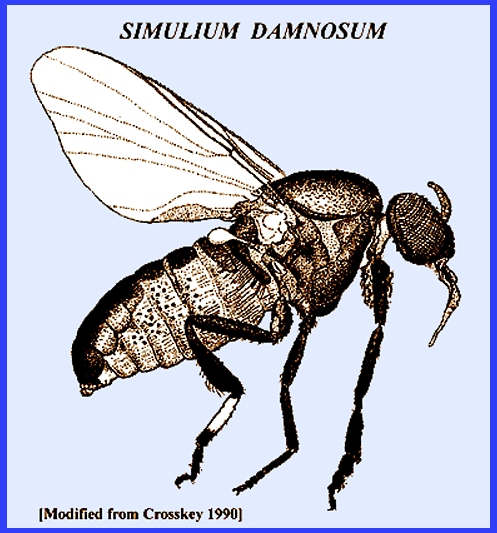File: <onchocerciasis.htm> <Medical
Index> <General Index> Site Description Glossary <Navigate
to Home>
|
ONCHOCERCIASIS (River
Blindness) (Contact) Please CLICK on
image & underlined links for details: In Africa the
Simulium damnosum
complex are the most important vectors of onchocerciasis. Adult flies of this complex are black and
are recognized by broad and flat front tarsi with a dorsal crest of tiny
hairs, and by a broad white area on the first segment of the hind tarsus
(Service 2008). Important vector
species are Simulium damnosum, S. sirbanum, S. sanctipauli and S.
leonense while S. neavei, S. . In America Simulium ochraceum (shown
as similar S. ochraceus)
vectors the disease in Mexico, Central and South America and S. metallicum in Mexico
and Central America to parts of northern South America. Service (2008) noted that Simulium exiguum is the only
vector in Colombia and it is also quite active in Ecuador. In Brazil Simulium
guianense and Simulium
oyapockense are vectors.
In South America Mansonella ozzardi
is also a filarial parasite that may be regarded as non pathogenic
(Service 2008). However there are
reports of it causing morbidity in Colombia and Brazil. The disease is vectored by Culicoides species (e.g., C. furens and C. phlebotomus) in the Caribbean area,
Trinidad and Surinam and to a lesser extent in Argentina. Simulium
amazonicum vectors M. ozzardi
in various parts of Panama and South America. Control
involves using repellants and applying insecticides to black fly breeding
areas. The World Health Organization
and local health agencies are active in implementing other control measures
in Africa especially. This includes
the widespread governmental use of insecticides, which ultimately will become
less effective as pesticide resistance develops. Therefore, education in avoidance through use of repellants
should reduce the number of people infected and the spread of disease. Control of Vectors & Disease Repellents
are the common means for reducing annoyance caused by blackfly vectors. Although Service (2008) suggested that the
application of insecticides to developmental sites of blackfly larvae is the
only practical control method, the development of insecticide resistance is
rapid and the degree of control drops significantly after only a few
years. There are drugs containing ivermectin to control the
microfilaria for those who have become infected. It is recommended that entire communities be treated with such
drugs to reduce the incidence of microfilaria
in the area, which in turn greatly reduces infection. Then the requirement for insecticidal
control of vectors is also reduced, which prolongs development of resistance. = = = = = = = = = = = =
= = = = = = = = Key References: <medvet.ref.htm> <Hexapoda> Adler, P. H., D. C.
Currie & D. M. Wood. 2004. The Black Flies (Simuliidae) of North
America. Comstock Publ. NY &
London Boatin, B. A. & F.
O. Richards. 2006. Control of onchocerciasis. Adv. in Parasitol. 61: 349-54. Crosskey, R. W. 1990.
The Natural History of Blackflies.
Wiley Publ., Chichester, England. Davies, J. B. 1994. Sixty years of onchocerciasis vector
control: a chronological summary with
comments on eradication, reinvasion and insecticide resistance. Ann. Rev. Ent.
39: 23-45. De Villiers, P.
C. 1987. Simulium
dermatitis in man: clinical and biological features in South Africa. So. Afr. Med. J. 71-523-525 Hougard, J. M., L.
Yameogo, A. Seketeli, H. Boatin & K. Y. Dadzie. 1997. Twenty-two years
of flack-fly control in the onchocerciasis control programme in West Africa. Parasitology Today 13: 425-28. Matheson, R. 1950. Medical Entomology. Comstock Publ. Co, Inc. 610 p. Legner, E.
F.
1995. Biological
control of Diptera of medical and veterinary importance. J. Vector Ecology 20(1): 59_120. Legner, E. F. 2000.
Biological control of aquatic Diptera. p. 847_870.
Contributions to a Manual of Palaearctic Diptera, Vol. 1, Science Herald, Budapest. 978 p. Molyneux, D. H.
2005. Onchocerciasis control
& elimination: coming of age in resource-constrained
health systems. Trends Parasitol. 21:
525-29. Raybould, J. N. & G. B. White. 1979.
The distribution, bionomics and control of onchocerciasis vectors
(Diptera: Simuliidae) in easter Africa and the Yemen. Tropenmedizin u. Parasitol.
30: 505-547. Service, M. W. 1977. Methods for sampling adult Simuliidae,
with special reference to the Simulium
damnosum complex. Trop.
Pest Bull. 5: 1- 48. Thylefors, B. &
M. Allman. 2006. Towards the elimination of
onchocerciasis. Ann. trop. Med. &
Parasitol. 100: 733-46. World Health
Organization. 2002. Success in Africa: the Onchocerciasis Control Programme in
West Africa, 1974-2002. WHO, Geneva. World Health Organization. 2004. Onchocerciasis
(river blindness): report from the 13th Inter-American Conf. on
Onchocerciasis, Cartagena de Indias, Colombia. Weekly Epidemiological
Record 79: 310-12. |
